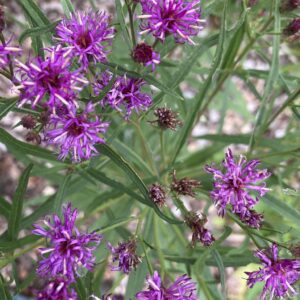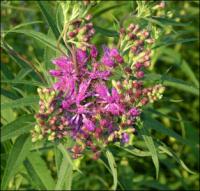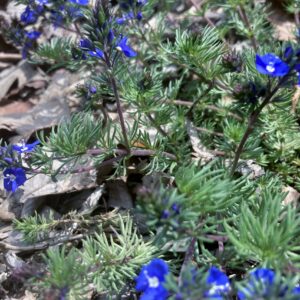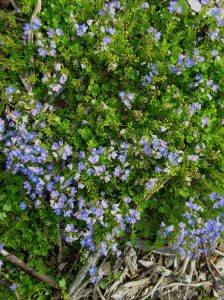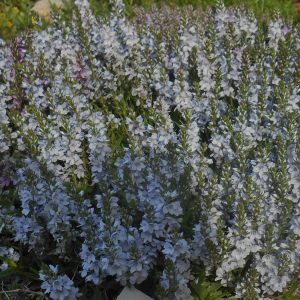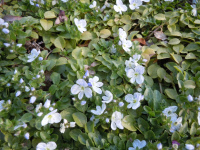Perennials & Biennials
Showing 497–504 of 512 results
-
Vernonia lettermannii Threadleaf ironweed Z 4-9
Deep purple inch-wide flower heads top unbranched stems forming a dome in late summer-early fall
Deep purple inch-wide flower heads top unbranched stems forming a dome in late summer-early fall
Size: 4-5’ x 36”
Care: sun in well-drained to moist well-drained soil
Native: Arkansas and OK
Wildlife Value: attracts numerous butterflies and pollen source for bees, deer resistant
Awards: Pennsylvania Horticultural Society Gold Medal 2023Collected on “Cooper’s Creek by Dr. J.M. Bigelow and on the sandbars of the Washita,.” Proc. Amer. Acad. Arts xvi. (1881) 78. 78 1880. “Notes on Some Compositae.” Vernonia named to honor Wm. Vernon (1666-1711) English botanist who collected plants in Maryland in late 1600’s. The species named to honor George Lettermann (1840-1913) who was primarily interested in trees and, while working for the US Census, collected tree specimens in forests of Missouri, Arkansas, western Louisiana and eastern Texas.
-
Vernonia noveboracensis Ironweed Z 4-8
Heads of numerous deep, royal purple, platter-forming flower several feet high above in late summer
Heads of numerous deep, royal purple, platter-forming flower several feet high above in late summer
Size: 6-7' x 3'
Care: Sun in moist to moist well-drained soil
Native: Massachusetts to Florida
Wildlife Value: attracts butterfliesNamed for English botanist William Vernon. Infusions of the plant used by Cherokee to relieve pain after childbirth, for loose teeth and for stomach ulcers.
-
Veronica armena Armenian speedwell Z 4-9
A peewee plant that packs a punch. In spring to early summer terminal clusters of cup-shaped Vermeer blue flowers made of 4 obovate, smooth-edged petals set off snow white eyes with matching white stamens. Below the floral crown forest-green, soft, needle-sized leaves frame the blue and detail texture for the rest of the season.
OUT OF STOCK
A peewee plant that packs a punch. In spring to early summer terminal clusters of cup-shaped Vermeer blue flowers made of 4 obovate, smooth-edged petals set off snow white eyes with matching white stamens. Below the floral crown forest-green, soft, needle-sized leaves frame the blue and detail texture for the rest of the season.
Size: 4” x 6” and spreading
Care: sun in well-drained soil
Native: Armenia, Georgia and TurkeyDiscovered before 1856 when it was named and described by Swiss explorer and botanist Pierre Edmond Boissier.
-
Veronica gentianoides Gentian speedwell Z. 4-9
Erect spikes of pale blue flowers sprouting above clumps of basal foliage in late spring/early summer.
Erect spikes of pale blue flowers sprouting above clumps of basal foliage in late spring/early summer.
Can not ship to: Illinois
Size: 18" x 12"
Care: sun to part shade in moist well-drained soil
Native: eastern Europe
Wildlife Value: attracts butterflies
Awards: England's Royal Horticultural Society Award of Merit.According to Christian tradition, as Jesus carried the cross to Calvary, a woman wiped his face with her handkerchief, leaving the imprint of the features of his face, the vera iconica, meaning “true likeness.” When the Catholic Church canonized the woman, the Church gave her the name Saint Veronica. Medieval gardeners named the plant after her due to the perceived likeness of the flower to her handkerchief. Introduced to European gardens by 1784.
-
Veronica liwanensis Turkish speedwell Z 4-8
Tiny true blue saucers smother the ground
OUT OF STOCK
Tiny true blue saucers smother the ground in May & June – groundcover, front of border or rock garden plant.
Size: 1” x 18” spreader over time
Care: sun to part shade in moist well-drained to well-drained soil
Native: NE Anatolia, Caucasus
Wildlife Value: attracts butterflies
Awards: 1997 Plant Select Winner.Collected before 1849.
-
Veronica officinalis Common speedwell Z 3-7
Mat-forming perennial with spikes of blue flowers with darker blue stripes on the petals, May-August
OUT OF STOCK
Mat-forming perennial with spikes of blue flowers with darker blue stripes on the petals, May-August
Size: 4-12” x 6”
Care: sun in dry, well-drained soil
Native: Europe and Asia
Wildlife Value: attracts beesUsed in European traditional medicine as a cough remedy and tonic as well as a salve. Used for centuries as a cure-all medicinal as long ago as ancient Rome. Grown at America’s 1st botanic garden, Elgin Botanic Garden 1811.
-
Veronica prostrata syn. V. rupestris Sprawling speedwell, Harebell speedwelll Z 4-8
From midspring to midsummer short blue spikes above prostrate foliage.
OUT OF STOCK
From midspring to midsummer short blue spikes above prostrate foliage.
Size: 6” x 18”spreads
Care: sun to part shade in moist well-drained soil.
Native: Europe
Wildlife Value: Deer and rabbit resistant.
Awards: Royal Horticultural Society Award of Garden Merit.In gardens since at least 1753 (Linnaeus). Bloomed for 4 or more months in rock garden at Edinburgh Botanic Garden (The Garden, Jan. 1876.)
-
Veronica repens Creeping speedwell Z 5-9
Palest of blue blooms in spring
OUT OF STOCK
Palest of blue blooms in spring on this low, creeping groundcover.
Size: 2” x 8-12”
Care: full sun to part shade in moist to moist well-drained soil
Native: CorsicaAccording to Christian tradition, as Jesus carried the cross to Calvary a woman wiped his face with her handkerchief, leaving the imprint of Christ’s features, the vera iconica, meaning “the true likeness.” When the Catholic Church canonized the woman the Church named her Saint Veronica. Medieval gardeners named the plant after her due to a perceived likeness of the flower to her handkerchief. This species collected by 1800. According to William Robinson, father of the mixed perennial garden, Veronica repens “clothes the soil with a soft carpet of bright green foliage, covered in spring with pale bluish flowers.”

